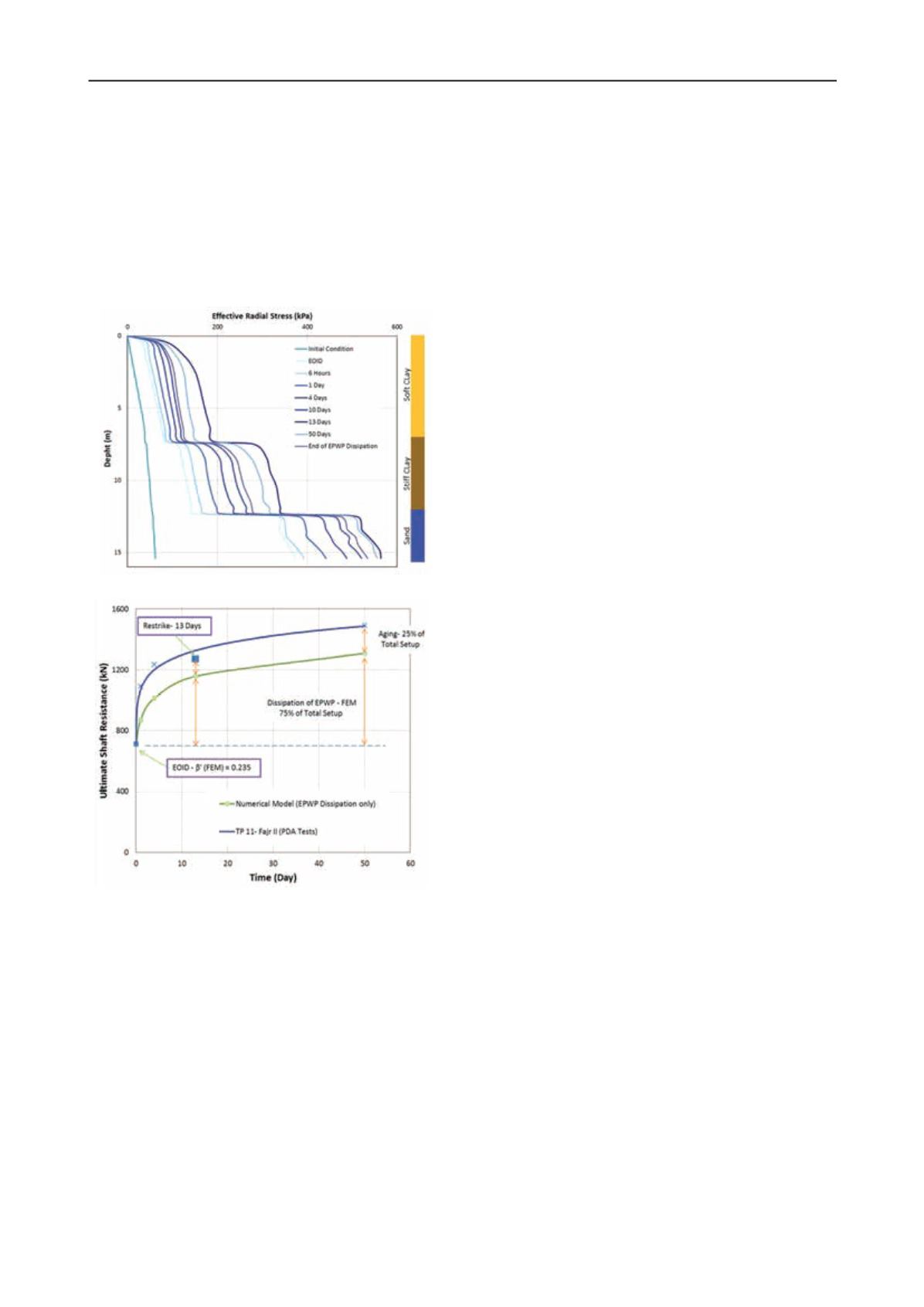
2730
Proceedings of the 18
th
International Conference on Soil Mechanics and Geotechnical Engineering, Paris 2013
To account for the aging setup effects, the interface frictional
resistance coefficient, expressed by
β′
factor in this study, has
been increased until correlations are obtained between predicted
and field measurements. This has been shown by the blue line in
Fig. 7. The difference between the two green and blue lines in
figure is assumed to be representing all the contributing factors
to soil setup that are not effective-stress related. Such factors are
referred to as “aging” in this study, and as explained, the
β′
factor is assumed to account for it. Figure 7 shows that the
contribution of dissipation of EPWP is 75% while the
contribution of aging is 25%.
Figure 6.Radial effective stress changes with timealong the pile shaft.
Figure 7.Increase in pile shaft capacity in numerical model.
5 CONCLUSION
The construction site ofFajr II utility plant,Mahshahr, Iranis
selected to study the different components contributing to the
setup effects using an elasto-perfectly plastic axisymmetric
FEM model. Theadopted FEM model is capable of effective
stress analysis and consideration of PWP effects and has been
used to simulate the cavity expansion resulted from pile driving
and subsequent dissipation of EPWP. The focus of study was to
distinguish the effective stress-dependent and independent
factors influencing the setup in layered strata. The findings of
the study are listed below:
-An empirical equation for calculation of shaft capacity
after setup is presented for the study area.Two equations
also are proposed as upper and lower bounds.
- The numerical model predictions compare well with field
measurements.
-The generation of EPWP as a result of cavity expansion
and subsequent dissipation with time has been predicted
reasonably well.
-The variation of interface shear strength reduction factor,
β′
is considered to represent the setup component
attributed to aging.
-In the layered media of the study site, the contribution of
dissipation of EPWP and aging to soil setup has been
estimated 75% and 25%, respectively, at about 50 days
after initial drive.
6 ACKNOWLEDGEMENTS
The authors would like to thank Amirkabir University of
Technology (AUT), Fajr Petrochemical Co., and Machine Sazi
Pars Co., for financing the extensive dynamic and static load
tests of this study.
7 REFERENCES
Axelsson, G. (2000). “Long-Term Set-up of Driven Piles in Sand” Ph.D
Thesis, Royal Institute of Technology, Stockholm, Sweden
Bullock, P. J., Schmertmann. J., McVay. M, and Townsend, F. (2005).
“Side Shear Set-up: Test Piles Driven in Florida.” Journal of
Geotechnical & Geoenvironmental Engineering, ASCE, 131(3),
292-30
Bullock. P. J., Schmertmann. J., McVay. M. and Townsend. F. (2005b).
“Side Shear Set-up. II: Results From Florida Test Piles” Journal of
Geotechnical & Geoenvironmental Engineering, ASCE, 131(3),
301-310
Fakharian, K., Bahrami, T., Esmaili, F., and Hosseinzadeh Attar, I.
(2012). “Dynamic and Static Tests for Optimization of Spun Piles
of a Utility Plant near Persian Gulf - Case Study” The 9th
International Conference on Testing and Design Methods for Deep
Foundations, 18-20 September, 2012, Kanazawa, Japan.
Fakharian, K. and Iraji, A. (2010).“Numerical modeling of suction pile
installation in Caspian Sea clay with effective and total stress
analyses” International Journal of Offshore and Polar Engineers
(IJOPE), Vol. 20, No. 4, pp. 313-320.
Haddad, H., Fakharian, K., and Hosseinzadeh Attar, I.
(2012).“Numerical Modeling of Setup Effects on Pile Shaft
Capacity and Comparison with an Instrumented Case” The 9th
International Conference on Testing and Design Methods for Deep
Foundations, 18-20 September, 2012, Kanazawa, Japan.
Komurka, E., Tuncer, B. E. and Wagner, A. (2003). “Estimating
Soil/Pile Set-Up” Wisconsin highway Research Program #0092-00-
14
Konrad, J. M. and Roy, M. (1987). “Bearing capacity of friction piles in
marine clay” Geotechnique 37, No. 2, 163-175
Rausche, F. Robinson, B. and Likins, G. (2004). “On The Prediction Of
Long Term Pile Capacity From End-Of-Driving Information”
Current Practices and Future Trends in Deep Foundations (GSP
125) pp. 77-95.
Sarrafzadeh, A, Fakharian, K., and Hosseinzadeh Attar, I. (2012).
“Investigation of bearing-capacity parameter variations with time
using PDA test results: case study” The 9th International
Conference on Testing and Design Methods for Deep Foundations,
18-20 September, 2012, Kanazawa, Japan.
Seidel, J. and Kolinowski, M. (2000). “Pile set-up in sands,” Procedures
of the 6th Int. Conf. on the Application of Stress Wave
Measurements to Piles, Sao Paulo, Brazil, Balkema, 267-274.
Svinkin, M. R. (1996). “Setup and Relaxation in Glacial Sand –
Discussion,” Journal of Geotechnical Engineering, Volume 122,
No. 4, ASCE, pp. 319-321.
Svinkin, M. R. and Skov, R. (2000). “Setup effects of cohesive soils in
pile capacity” Proc. 6th International Conference on Application of
Stress-Wave Theory to Piles, Sao Paulo, Brazil, Balkema, pp. 107-
111.


